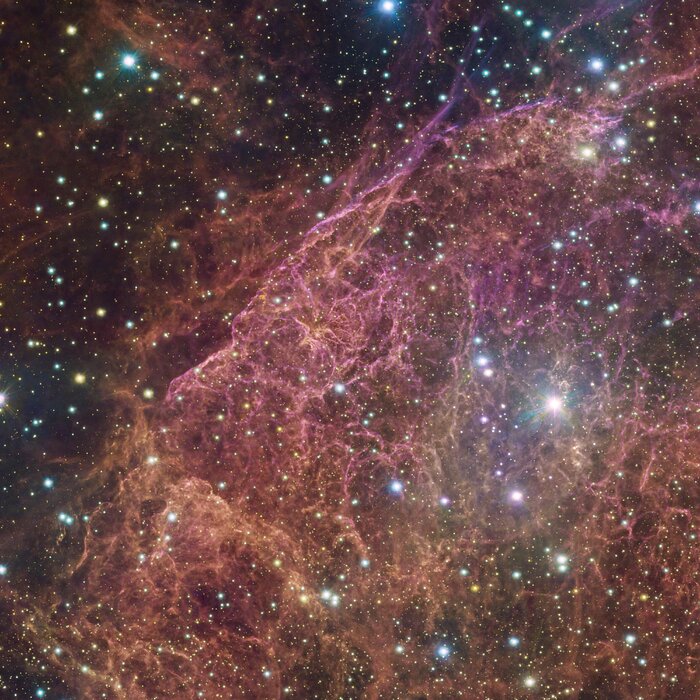Giant cosmic networks
Sometimes dramatic events are needed to create something stunning. This beautiful structure of filaments and clouds in the southern constellation of Vela are all that remains of a massive star that died in a powerful explosion known as supernova. This is a small section of a larger image taken using the wide-field camera OmegaCAM at the VLT Survey Telescope (VST). Hosted at ESO’s Paranal Observatory in the Chilean desert, the VST is one of the best telescopes in the world to take large images of the sky in visible light.
Even though bright stars populate this image, it's hard to not be captivated by the pink gaseous clouds filling up the frame. Some tiny, others thicker, the filaments stretch outwards like tentacles. As they intertwine and cling together, an intricate network is formed which mixes with blurred clouds. But how did they come to be like this?
Around 11 000 years ago, a massive star exploded as a supernova, ejecting its outer layers. The explosion also generated shock waves which traveled outwards, compressing the gas around the star and creating the intricate network visible in the image. The result of such explosions are called supernova remnants. At 800 light years away from Earth, the Vela supernova remnant is one of the closest known to us.
Crediti:ESO/VPHAS+ team. Acknowledgement: Cambridge Astronomical Survey Unit
A proposito dell'immagine
| Identificazione: | potw2322a |
| Tipo: | Osservazione |
| Data di pubblicazione: | Lunedì 29 Maggio 2023 06:00 |
| Dimensione: | 6697 x 6698 px |
A proposito delll'oggetto
| Nome: | Vela Supernova Remnant |
| Tipo: | Milky Way : Nebula : Type : Supernova Remnant |
| Distanza: | 800 Anni luce |
| Constellation: | Vela |
| Categoria: | Nebulae |
Formati delle immagini
Coordinate
| Position (RA): | 8 33 49.52 |
| Position (Dec): | -43° 39' 4.37" |
| Field of view: | 24.62 x 24.63 arcminutes |
| Orientazione: | Il Nord è a 0.4° a sinistra della verticale |
Colori e filtri
| Banda | Lunghezza d'onda | Telescopio |
|---|---|---|
| Ottico u | 350 nm | VLT Survey Telescope OmegaCAM |
| Ottico g | 480 nm | VLT Survey Telescope OmegaCAM |
| Ottico r | 625 nm | VLT Survey Telescope OmegaCAM |
| Ottico H-alpha | 659 nm | VLT Survey Telescope OmegaCAM |
| Ottico i | 770 nm | VLT Survey Telescope OmegaCAM |

